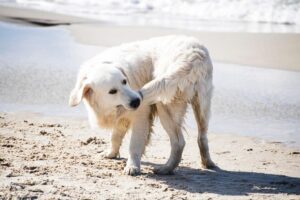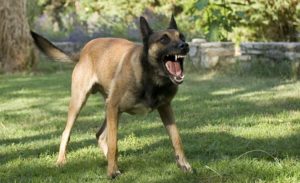A lot of our visitors have asked for advice to help letter carriers, meter readers, gardeners and other workers avoid being bitten when they have to go into a yard with a dog in it. It’s a valid concern. Just among postal workers in 2014, there were nearly 6,000 bites or attacks in the U.S. alone.
However, this advice isn’t meant just for people who have to enter strange yards in their line of work. These tips will help anyone who wants to enter a dog’s territory without being bitten. First, make sure to apply Cesar’s golden rule of approaching a dog: no touch, no talk, no eye contact, then do the below:
- Get acquainted
Approaching a strange dog is never a good idea. If you come across a dog that’s tethered in a yard, keep your distance. Being tied up can make a dog more defensive or aggressive. If there’s a dog that you haven’t met before loose in a yard, it’s a good idea to leave a note for the owners or call first to arrange a time when you can be introduced to the dog in the owner’s presence.If you’re not sure whether there’s a dog in the yard, make a noise first, like rattling the gate or whistling. If there is a dog there, he’ll let you know pretty quickly. And if it’s not possible to arrange an introduction with the dog, use the following tips to stay safe.
- Know the warning signs — and the odds
Learn how to spot indications that a dog is aggressive or fearful, both mental states that can lead to an attack. The stiffer the body the more tense the dog is. Watch for pulled back head or ears or both, a stiff tail, eyes rolled back, intense staring, or the dog backing away.If the dog is more than about a hundred pounds or there are two or more dogs in the yard, reconsider whether you should enter. A large dog can knock you down and make an attack worse, while two dogs will work together to hunt and trap you.
- Put on a friendly face
If you’re wearing a hat or sunglasses, remove them — many dogs are naturally leery of headgear, particularly utility worker’s hard-hats and letter carrier’s pith helmets. This is because large, solid objects like these make your head appear bigger so make you appear more intimidating; sunglasses make it look like you have enormous, staring eyes. Either of these can trigger a defensive attack from a fearful dog.
- Avoiding an attack
If you think a dog is threatening you or about to attack, don’t run. This will just trigger the dog’s prey drive and make her chase you down. Don’t yell or scream. Remain motionless until the dog leaves or loses interest, then back away slowly until you’re out of the dog’s sight.There’s some disagreement on whether you should stare the dog down in this situation. Generally, it’s probably safer not to make eye contact unless the dog is showing fear-aggression. But do remember to remain calm and assertive and stand tall as you make your exit.
- If an attack happens…
If it looks like the dog is about to attack you, put something between you and him — preferably an object that’s soft and compressible. Letter carriers probably already have the perfect defense on them — their mail bag — but if you’re wearing a sweater and can get at least one arm out of a sleeve, that will work as well. Canvas tool bags will also do the trick.The idea here is to put something in front of the dog that isn’t part of you. This creates a new target for the bite, which the dog will think is you. If the dog does attack, it will go for that object and hang on. This is why it’s so important that it’s something compressible — if it’s a hard object that hurts their mouth, like a metal pole or stick, they’re much more likely to let go and bite something else.
Don’t use pepper spray or mace on an already aggressive dog. They don’t always work and a dog’s face can be a hard target to hit. An improper attempt can just make the dog more aggressive, especially if the spray makes a hissing noise. Also, don’t bother bringing along treats to bribe the dog. If they’re fearful or aggressive, they won’t even notice.
Of course, the best way to prevent postal and other workers from being attacked by dogs is to educate the owners. If someone knows in advance what day and time the meter reader is coming or if the times the gardener shows up or the mail is delivered are consistent, then it’s easier for them to plan to have their dog inside.
Owners also have to be aware that the phrase “my dog doesn’t bite” is never 100 percent true. Any dog, in the right circumstances, can be startled or scared enough by an invasion of its territory to do what dogs naturally do: protect the pack from a threat. That response may be limited to a timid growl or a loud bark — but it can also escalate to a full-on attack.
With a combination of careful workers and considerate owners, maybe we can take a bite out of the number of letter carriers, and others, bitten each year.










